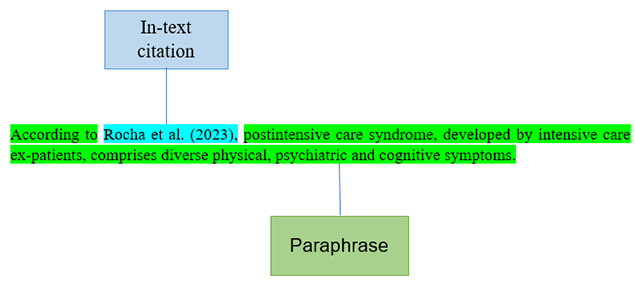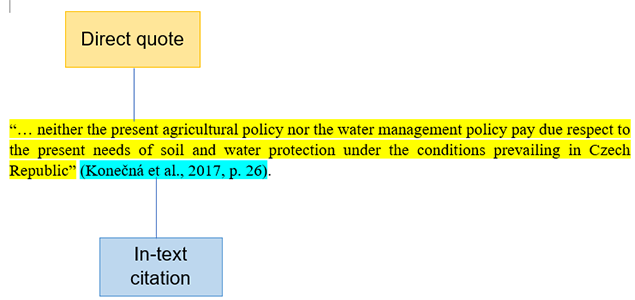Citation style of Mendel University in Brno or the Library Recommends
This citation style was created for the needs of students and academics of Mendel University in Brno. With this style, it is possible to cite the literature used, for example, in seminar and thesis papers, scientific publications or to report one's own publishing activity.
For information on this citation style and guidance on how to cite different types of sources, including examples, see the booklet Citation style of Mendel University in Brno or the Library recommends.
Bibliographical references and citations
- Why cite?
- What is a citation and what does it look like?
- What are the citation principles?
- When is it not necessary to cite?
- How to manage bibliographic citation records? Reference managers
- Recommended literature
- Contact for your questions and comments
Why cite?
Part of the study is writing seminar and thesis papers, in more advanced stages of study and in follow-up scientific activity also writing professional articles or other scientific publications. In all academic texts, all sources used in the writing of the text must be correctly referenced or cited.
By proper citation:
- you avoid the risk of plagiarism and infringement of others' copyrights;
- you comply with the principles of citation ethics and the principles of good scientific practice, as well as with legislative and university regulations (the topic of prevention and detection of plagiarism is addressed by Rector's Directive 2/2021;
- you will show that you are familiar with the relevant literature and can work with it;
- you clearly declare which expert sources you are relying on and what you are basing your argumentation on, or what you are defining yourself against;
- you enable your readers to find cited sources and verify your claims or to add more interesting information on the topic.
What is a citation and what does it look like?
By citation, we mean providing details of the source used in writing the text. A citation can take the form of:
- a reference to a source in the text (either in the form of a brief, abbreviated reference to the source cited or a numerical reference to the full bibliographic entry in the reference list or a footnote);
- a complete bibliographic information on the source cited, which is included in the final reference list (or footnotes) and contains all the information necessary to trace the source unambiguously. This complete record is called a bibliographic citation.
In-text citations may take different forms. The Library Recommends citation style uses the Harvard method, where in-text citations are given in the form: (author, year).
Example:


Reference list (list of bibliographic citations)
In the reference list at the end of the text, we list all the sources that we have used in the writing of the work, i.e. to which we have referred in the relevant parts of our text.
KONEČNÁ, Jana et al. 2017. Integration of soil and water conservation measures in an intensively cultivated watershed – a case study of Jihlava river basin (Czech Republic). European Countryside. 9(1), 17-28. ISSN 1803-417. https://doi.org/10.1515/euco-2017-0002
ROCHA, Franciani Rodrigues da et al. 2023. Biomarkers of neuropsychiatric dysfunction in intensive care unit survivors: A prospective cohort study. Critical Care Science. 35(2), 147–155. ISSN 2965-2774. https://doi.org/10.5935/2965-2774.20230422-en
What are the citation principles?
- Use the same rules and formatting for all references in your work. Be consistent and systematic – use one citation style and one citation method. In the list of references, only cite the documents and sources that you have actually used in writing your paper.
- In the bibliographic references (the full details of the source cited in the reference list), include all the information according to the requirements of the citation style you have chosen. Do not abbreviate or edit citations.
- Always take the data for creating citations from the primary document, i.e. directly from a book or other information source that you have "had in your hand".
- Keep in mind that the cited source must always be traceable.
- If you cite an online source, provide all the required information according to the guidelines of the relevant citation style. As with printed documents, the source used must be clearly identifiable and traceable.
- If any of the required information is supplied from external sources (e.g. missing year of publication), please indicate it in square brackets.
- If you use a citation tool (reference manager or generator) to create citations, double-check the result.
And further remember that:
- if you adopt a text, figure, graph, table, etc. into the text of your paper, cite the author and source;
- if you use data from another author or institution to create your table or graph, please indicate the author and source;
- if you adopt someone else's idea, opinion, result of work into the text of your work, cite the author and source;
- if you use part of your own published work in your writing, cite yourself.
When is it not necessary to cite?
- When you state commonly known facts or refer to phenomena that are part of common knowledge and education (e.g. Prague is the capital of the Czech Republic, references to commonly known elements of legends, myths or shared cultural heritage, commonly known historical events, etc.). However, this is only true when referring to such a phenomenon in general, not, for example, when introducing different approaches to the study of such a phenomenon or specifying any of its details.
- When you refer in general terms to facts or terms that are established and generally accepted within your field.
- If you use your own data and results or if you present your own observations, comments and interpretations (but beware of using previously published data, results, interpretations, etc., which must be cited).
How to manage bibliographic citation records? Reference managers
Reference managers (also called bibliographic managers) facilitate the creation and management of citations. Reference managers offer a large number of citation styles for different types of documents, they also allow importing records from databases, linking bibliographic records to full texts or custom notes, and offer other specific features depending on the particular tool.
- Citation PRO PLUS - online tool for generating and managing citations. After logging in, the user is automatically set to the citation style "Mendel University in Brno" (= The Library Recommends citation style). You can also switch between many other citation styles as needed. The manager allows importing records from databases and working with full texts, provides an add-on for working in MS WORD, etc. For students and academic staff of MENDELU this paid version of the reference manager is available free of charge.
- Zotero – a free open-source tool for generating and managing citations. It offers different types of citation styles, allows you to create your own citation styles, and import records from databases, the Internet or external sources. Instructions for installing and using Zotero can be found on the Zotero Documentation Web page; for a basic overview, you can use a quick start guide.
- Mendeley - a free tool for managing, reading, sharing, annotating, and citing scientific documents. In addition, it provides a network of users and allows scientists working on similar projects to connect. The manager also monitors research trends and statistics. Guides for installing and working with Mendeley (About the product).
- EndNote - a tool for generating and managing citations. It is available online on the Web of Science platform from all MENDELU computers and remotely by connecting to a proxy server. EndNote allows for direct import of records from databases available on this platform (Web of Science Core Collection, BIOSIS Citation Index, Zoological Records, etc.). A license is required to access the desktop version, which is granted to researchers, academics, and Ph.D. students at MENDELU upon request (write to marija.supicova [at] mendelu.cz). For a basic introduction, you can use a Quick Reference Guide, for a more comprehensive training, you can access this manual. Additional text and video instructions. (About the product)
Recommended literature
BAILEY, Stephen. 2018. Academic Writing: A Handbook for International Students. London: Routledge. ISBN 978-1-138-04874-4.
FOLTÝNEK, Tomáš et al. 2020. How to Avoid Plagiarism: Student Handbook. Prague: Charles University, Karolinum Press. ISBN 978-80-246-4816-3. https://www.akademickaetika.cz/static/soubory/stranka-36/how-to-avoid-plagiarism-student-handbook-27.pdf
MENDELU Library. 2023. Citation Style of Mendel University in Brno or the Library Recommends. Version 3. Brno: Department of Scientific and Pedagogical Information and Services, Mendel University in Brno, 1. 9. 2023. [cit. 2024-02-16]. https://web2.mendelu.cz/cp_944_navody/Navody/c/Citation_Library_recommends-v3.pdf
Contact for your questions and comments
Mgr. Bc. Michaela Ondrašinová, PhD. citace[at]mendelu.cz
